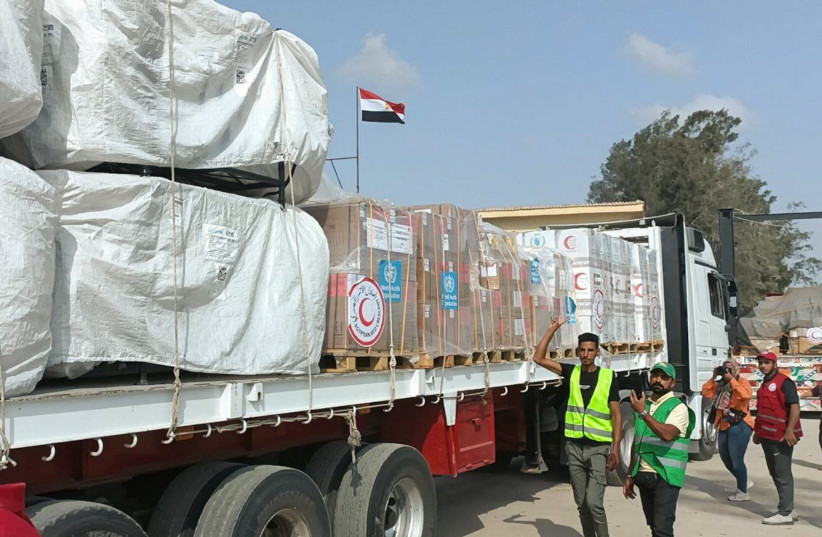Defense Minister Yoav Gallant on Wednesday announced what he called “new major breakthroughs” that would jump the humanitarian aid going into Gaza from around 200 trucks per day last week to well over 500 trucks per day.
The increase in aid would come as part of five new initiatives, Gallant said.
The new initiatives include:
- Implementing last Thursday’s government decision to open up Ashdod Port to increase the entry of goods and streamline security checks.
- Implementing last Thursday’s government decision to open up a new northern crossing (reportedly Erez), which would provide a route to bring aid directly to northern Gaza and reduce pressure on the Kerem Shalom crossing.
- Boosting aid through Jordan with two routes, including cooperation with the Jordanian Air Force, for a total of 150 trucks). This will set the foundation for future hubs.
- Establishing the coordination and deconfliction mechanism, which is part of a wider effort to increase cooperation with international organizations, implement lessons learned, such as the World Central Kitchen incident, and work with new partners.
- Other major projects, including working with the US on the JLOTS artificial island for absorbing and distributing maritime aid, COGAT working on infrastructure projects, such as water lines, and other meetings with new aid organizations.

“These breakthroughs have a direct impact on the flow of aid,” Gallant said. “We plan to flood Gaza with aid, and we are expecting to reach 500 trucks per day” very soon. “It will also streamline security checks and strengthen our work with international partners.”
He also discussed how humanitarian aid has already spiked dramatically since last week.
On Tuesday, “we saw a record number of 467 trucks, and air-dropped 303 packages,” Gallant said. “Last month, the daily average was 213, and before that it was 170.”
“Our policy has evolved to facilitate more and more aid, as we improved work with partners and created the operational conditions to enable such work,” he said.
Although Gallant said he was pushing for many of these new initiatives since his meetings in Washington on March 25-26, he has received much stronger backing from Prime Minister Benjamin Netanyahu since US President Joe Biden threatened the prime minister last Thursday.
Future crossings into Gaza
Going forward, there will be four land crossings for aid: Nitzana, Kerem Shalom, Crossing 96, and the “northern crossing,” which is said to be Erez.
Israel has already facilitated the delivery of 407,400 tons of humanitarian aid on over 21,638 trucks, Gallant said.
There have been 62 air-drop missions that delivered 3,608 packages, he said.
There are seven working field hospitals and two in the planning stages (IMC and Red Cross), Gallant said.
Despite these improvements, increasing aid will face challenges “in terms of securing and distributing aid,” he said. “This is the result of Hamas threats and also the issue of planning for the day after Hamas.”
“There are three bad options for the day after: Hamas controlling Gaza, Israel controlling Gaza, and total anarchy,” Gallant said. “We need to create another option: to empower a local alternative. The humanitarian effort is key in empowering a local alternative.”
Defense sources have in the past accused Netanyahu of blocking initiatives to build local alternatives based on forces affiliated with Fatah in Gaza, including having the US train them in Jordan.
There was still no confirmation that Netanyahu has reversed himself on this issue given his general preference to weaken, or at least not strengthen, the Palestinian Authority.
